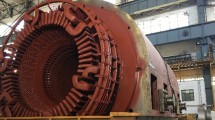Abstract
With the capacities of large-scale turbine generators increase, higher electrical and thermal loads may cause higher risk of thermal faults. Especially, for those air cooling machines with single channel ventilation system, the comparatively poor thermal conductibility of air makes the air-gap become a critical part in thermal transmission network. Thus, the heat transfer in air-gap of large scale turbine generators is followed with interest. The investigation is performed on a 150 MW air cooling turbine generator with single channel ventilation cooling system, and realized via the thermal-fluid coupling field studying. A nonlinear numerical calculation model for fluid flowing and heat transfer within the machine is proposed, and solved by finite volume method (FVM). Then, the heat transfer in the air-gap is analyzed, whilst the temperature distributions in machine different parts, as windings, stator core, and rotor components, are investigated. In addition, the velocity vector distribution of coolant in the ventilation system is also studied, and the air motion track in the air-gap is analyzed while considering the influence of rotor rotation. Finally, the influence of flow in the air-gap on fluid flowing in the stator radial ventilation ducts is investigated.












Similar content being viewed by others
References
Taniyama Y, Ueda T et al (2009) Technologies for high efficiency large capacity turbine generator. In 2009 International Conference on Electrical Machines and Systems pp. 1–6
Hosain ML, Fdhila RB et al (2017) Tayor-couette flow and transient heat transfer inside the annulus air-gap of rotating electrical machines. Appl Energy 207:624–633
Nachouane AB et al (2013) Numerical study of convective heat transfer in the end regions of a totally enclosed permanent magnet synchronous machine. IEEE Trans Ind Appl 28:117–124
Yoo W, Jeon S et al (2016) Full surface heat transfer characteristics of rotor ventilation duct of a turbine generator. Appl Ther En 94:385–394
Franc J, Pechanek R et al (2016) Optimisation of ventilation system of the air-cooled turbo generator. In 2016 17th International Conference on Mechatronics-Mechatronika (ME) pp. 1–5
Dang DD, Pham XT et al (2018) CFD analysis of turbulent convective heat transfer in a hydro-generator rotor-stator system. Appl Ther Eng 130:17–28
Boughrara K, Dubas F et al (2018) 2-D exact analytical method for steady-state heat transfer prediction in rotating electrical machines. IEEE Trans on Mag 54:1–19
Schrittwieser M, Marn A et al (2014) Numerical analysis of heat transfer and flow of stator duct models. IEEE Trans on Ind Appl 50:226–233
Gai Y, Kimiabeigi M (2018) On the measurement and modeling of the heat transfer coefficient of a hollow-shaft rotary cooling system for a traction motor. IEEE Trans on Ind Appl 54:5978–5987
Jichao H, Baojun Ge et al (2017) Calculation and analysis of complex fluid flow and thermal fields in a fully air-cooled hydrogenerator. Int J Ther Sci 116:278–286
Sarafraz MM, Arjomandi M et al (2018) Demonstration of plausible application of gallium nano-suspension in microchannel solar thermal receiver: Experimental assessment of thermo-hydraulic performance of microchannel. Inter Comm in Heat and Mass Transfer 94:39–46
Farahmand F, Dawson FP et al (2009) Temperature rise and free-convection heat-transfer coefficient for two-dimensional pot-core inductors and transformers. IEEE Trans on Indu Appl 45:2080–2089
Liao C, Ruan J et al (2014) 3-D coupled electromagnetic-fluid-thermal analysis of oil-immersed triangular wound core transformer. IEEE Trans on Mag 50:1–4
Huang X, Li L et al (2014) Temperature calculation for tubular linear motor by combination of thermal circuit and temperature field method considering the linear motion of air gap. IEEE Trans on Ind Elec 61:3923–3941
Howey DA, Childs PR et al (2012) Air-gap convection in rotating electrical machines. IEEE Trans Ind Electron 59:1367–1375
Gao J, Guo H, Gu G (2010) Study of the heat-transfer in the wedge-shaped air gap of evaporative cooling turbo generator. In 2010 International Conference on Electrical Machines and Systems pp. 1920–1923
Hosain ML, Fdhila RB et al (2017) Air-gap heat transfer in rotating electrical machines: a parametric study. Intern Confe on Appl Energy 142(2017):4176–4181
Wei Y (1998) Heat exchange in the motor [Chinese]. Machinery Industry Press, Beijing, pp 185–208
Kim S-E, Choudhury D et al (1995) A Near-Wall Treatment Using Wall Functions Sensitized to Pressure Gradient. Fluids Eng Division 217:273–280
De Marinis D, de Tullio MD, Napolitano M et al (2016) Improving a conjugate-heat transfer immersed-boundary method. Int J Numer Methods Heat Fluid Flow 26:1272–1288
Traxler-Samek G, Zickermann R, Schwery A et al (2010) Cooling airflow, losses, temperatures in large air-cooled synchronous machines. IEEE Trans on Ind Elect 57:172–180
Aguiar AB, Merkhouf A et al (2014) A new approach for computation of magnetic core losses in large hydro electrical generator. In IECON 2013-39th Annual Conference of the IEEE Industrial Electronics Society pp 2506–2511
Weili L, Ying S et al (2016) Stator temperature field of large-scale air-cooled turbine generator considering main insulation shelling. In 2016 IEEE Conference on Electromagnetic Field Computation (CEFC) p 1
Wang G, Li X et al (2012) Design, manufacture and operation of large steam turbine generators. Shanghai, Shanghai Science and Technology Press, China pp 155–179
Ying Su, Li W et al (2019) Influence of incident angle of hydrogen in the ventilation ducts on multi-physical fields of 1100 MW turbine-generator rotor. Int J Heat Mass Transf 140:852–861
Acknowledgements
National Natural Science Foundation of China (51477005)
Author information
Authors and Affiliations
Corresponding author
Additional information
Publisher's Note
Springer Nature remains neutral with regard to jurisdictional claims in published maps and institutional affiliations.
Rights and permissions
About this article
Cite this article
Su, Y., Zhuang, X., Zhu, X. et al. Heat transfer in air-gap and thermal-fluid coupling field of a large-scale turbine generator. Heat Mass Transfer 59, 269–282 (2023). https://doi.org/10.1007/s00231-022-03262-7
Received:
Accepted:
Published:
Issue Date:
DOI: https://doi.org/10.1007/s00231-022-03262-7




